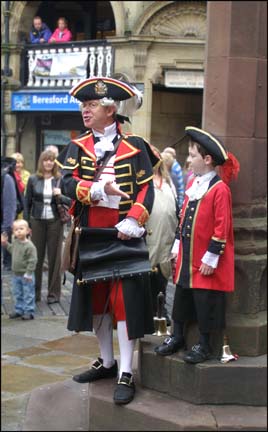 "In whatever point of view these old ramparts are considered, they possess an imposing interest and confer incalculable benefits. To the invalid, the sedenatary student, or the man of business, occupied during the day in his shop or counting house; to the habitually indolent, who require excitement to necessary exercise, to all these, the promenade on Chester walls has most inviting attractions, where they may breath all the salubrous winds of heaven in a morning or an evening walk. "In whatever point of view these old ramparts are considered, they possess an imposing interest and confer incalculable benefits. To the invalid, the sedenatary student, or the man of business, occupied during the day in his shop or counting house; to the habitually indolent, who require excitement to necessary exercise, to all these, the promenade on Chester walls has most inviting attractions, where they may breath all the salubrous winds of heaven in a morning or an evening walk.
Here the enthusiastic antiquarian, who would climb mountains, ford rivers, explore the bowels of the earth, and, regardless of toil, and the claims of nature, exhaust his strength in the search for a piece of rusty cankered brass, or a scrap of Roman earthenware, can scarcely advance a dozen paces, but the pavement on which he treads, or some contiguous object, forces upon his observation the reliques of times of earliest date.
Nor can the philosophic moralist encompass our venerable walls without having his mind, comparing the splendid and gigantic works of antiquity with their present condition, strongly impressed with the mutations produced by the lapse of ages, and the perishing nature of all mundane greatness".
Joseph Hemingway: Panorama of the City of Chester 1836
 n
1069,
Chester
was
the
last
city
in
England to
fall
to
William
the
Conqueror's
army,
a
full
three
years
after
the
Battle
of
Hastings. Rumours
had
long
circulated
among
the
Norman
troops
about
the
difficult
roads,
the
position
of
the
city-
surrounded
as
it
was
by
marshes
and
great
forests-
of
its
numerous
inhabitants-
and
of
their
obstinate
courage: "Locorum
asperitatum
et
hostium
terribilem
ferocitatem". n
1069,
Chester
was
the
last
city
in
England to
fall
to
William
the
Conqueror's
army,
a
full
three
years
after
the
Battle
of
Hastings. Rumours
had
long
circulated
among
the
Norman
troops
about
the
difficult
roads,
the
position
of
the
city-
surrounded
as
it
was
by
marshes
and
great
forests-
of
its
numerous
inhabitants-
and
of
their
obstinate
courage: "Locorum
asperitatum
et
hostium
terribilem
ferocitatem".
Many
of
William's
nobles,
worn
out
by
the
bloody
struggles
to
repress
rebellions
in
Yorkshire
and
Northumberland
during
the Harrying
of
the
North,
and
alarmed
at
these
rumours,
demanded
their
discharge.
Some
retreated
to
their
estates
in
Normandy
and
abandoned
the
English
lands
with
which
they
had
already
been
rewarded.
But
the
persuasive
powers
of
Duke
William
prevailed.
With
the
conquest
of
Chester,
he
told
them,
their
labours
would
be
at
an
end
and
rest
and
great
rewards
would
follow.
As
it
turned
out,
as
the
Norman
army
drew
near,
the
city-
whose
citizens
had
doubtless
heard
equally
terrifying
rumours
regarding
the
approaching
foe-
surrendered.
How
much
resistance
they
put
up
is
unknown,
but,
seventeen
years after
the
city's
fall,
the Domesday
Book stated
that
before
1066
there
had
been
431
houses,
"plus
56
more
owned
by
the
Bishop"
in
the
city
and
that
it
paid
fourty
five
pounds
"and
one
hundred
and
twenty
martin
skins"
but,
"When
Earl
Hugh
acquired
it,
its
value
was
only
thirty
pounds,
having
been
much
devastated;
there
were
205
houses
less
than
before
1066".
 Duke
William
granted
the
Earldom
of
Chester
first
to Walter
de
Gherbaud,
who,
however
soon
returned
to
Normandy,
and
then
to
his
nephew, Hugh
d'Avranches,
know
as Lupus (The
Wolf)
-
"to
hold
to
him
and
his
heirs
as
freely
by
the
sword
as
the
King
holds
the
Crown
of
England".
Ordericus
described
him
thus: Duke
William
granted
the
Earldom
of
Chester
first
to Walter
de
Gherbaud,
who,
however
soon
returned
to
Normandy,
and
then
to
his
nephew, Hugh
d'Avranches,
know
as Lupus (The
Wolf)
-
"to
hold
to
him
and
his
heirs
as
freely
by
the
sword
as
the
King
holds
the
Crown
of
England".
Ordericus
described
him
thus:
"He
was
not
abudantly
liberal,
but
he
was
profusely
prodigal
and
carried
not
so
much
a
family
as
an
army
around
with
him.
He
took
no
account
either
of
receipts
or
disbursements;
he
daily
wasted
his
Estate
and
delighted
more
in
falconers
and
huntsmen
than
in
the
tillers
of
his
land
or
Heaven's
orators,
the
Ministers.
He
was
much
given
to
his
belly,
whereby
in
time
he
grew
so
fat
that
he
could
scarce
crawle.
He
had
many
bastard
sons
and
daughters,
but
they
were
nearly
all
swept
away
by
sundry
misfortunes".
Actually, there is no evidence that Earl Hugh was called by the unpleasant name of Lupus during his lifetime or indeed for long years after his death. It was given to him in later ages on account of his traditional gluttony and rapacity. The Welsh called him Hugh the fat or gross, 'Hu vras', and the Danes 'Hugh Dirgane' which has the same meaning. The earliest instance of the use of the nickname Lupus occurs in an inquisition as late as 1305- "Hugo le Lou
formerly Earl of Chester".
The
Earldom
became
very
powerful
and
virtually
independent
of
the
Crown,
the
Earl
having
his
own
Parliament
consisting
of
eight
of
his
chosen
Barons
and
their
tenants,
and
they
were
in
no
way
bound
by
any
laws
passed
by
the
English
Parliament
with
the
exception
of
treason.
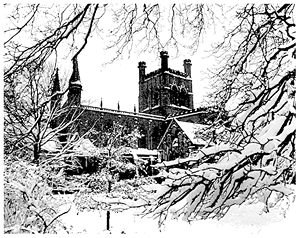 The
Saxon Castle was
rebuilt
and
greatly
enlarged
and
strengthened,
becoming
the caput of
the
Earldom-
as
were
the
city
walls. The
Saxon Castle was
rebuilt
and
greatly
enlarged
and
strengthened,
becoming
the caput of
the
Earldom-
as
were
the
city
walls.
In
1093,
in
the
last
days
of
his
life,
Earl
Hugh
founded
the Benedictine
Abbey
of
St. Werburgh, "To
make
provision
for
his
immortal
soul
and
and
to
compensate
to
some
degree
for
the
sins
which
he
had
committed".
In
time,
the
Abbey
became
extremely
rich
and
powerful,
owning
land
and
property
throughout
Cheshire
and
far
beyond.
The
Earls
of
Chester
gave
the
Abbots
rights
equal
within
their
jurisdiction
to
their
own,
which
were
themselves
equal
to
those
of
the
Crown
elsewhere
in
the
country.
The
medieval
trials
by
fire,
water
and
combat
were
practiced
in
the
Abbot's
courts
and
malefactors
were
executed
by
the
Abbot's
officers.
After
the
Dissolution
in
1540,
the
Abbey
became Chester
Cathedral.
During
the
13th
century
the
city
played
a
major
role
in
Edward
I's
subjugation
of
the
Welsh,
who
had,
from
the
8th
century,
when
the
Mercian
King
Offa
had
built
his
great
dyke
to
keep
out
the
dispossessed
Welsh
of
Gwynedd,
Powys
and
Gwent,
long
proved
a
very
real
threat.
The
wars
of
1277
and
1282
resulted
in
the
death
of
the
powerful
Welsh
Prince
Llewellyn
and
the
final
conquest
of
North
Wales.
Many
of
the
violent
events
of
the
revolt
against
the
English
led
by
Owen
Glendower
between
1400
and
1412
took
place
along
the
border
on
the
banks
of
the
River
Dee
near
Chester
and
in
North
Wales.
Two
and
a
half
centuries
later
Chester's
walls
witnessed
bloody
conflict
for
a
final
time,
Englishman
against
Englishman,
during
the Civil
War,
when
Royalist
Chester
eventually
fell
to
Parliamentary
forces
after
a
bitter
and
lengthy
siege
During
the
late
18th
and
early
19th
centuries,
the
formidable
medieval
entrances
to
the
city,
the Northgate, Eastgate, Watergate and Bridgegate,
being
considered
obstructions
to
traffic
in
the
increasingly
busy
town,
were
removed
and
replaced
with
the
present
elegant
arches-
but
retained
their
ancient
names.
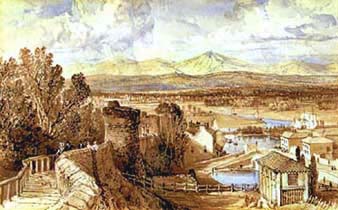 A
smaller
entrance,
the Shipgate,
which
formerly
stood
near
the
Bridgegate,
was
completely
removed
and
now
stands
as
a
decorative
folly
in
Grosvenor
Park and its neighbour, the Horsegate, vanished without trace. A
smaller
entrance,
the Shipgate,
which
formerly
stood
near
the
Bridgegate,
was
completely
removed
and
now
stands
as
a
decorative
folly
in
Grosvenor
Park and its neighbour, the Horsegate, vanished without trace.
The
ancient Peppergate,
or Wolfgate,
still
stands in
situ,
but
in
the
1930s,
together
with
the
nearby
Roman Amphitheatre,
narrowly
escaped
destruction
when
the
road
was
diverted
to
allow
traffic
to
use
a
larger
entrance
built
alongside,
appropriately
known
as
the Newgate,
which
now
forms
part
of
the
traffic-choked inner
ring
road.
In
1966,
as
part
of
this
new
road
scheme,
the
walls
were
pierced
once
again,
this
latest
entrance
being
called St. Martin's
Gate,
situated
approximately
where
the
artist Thomas
Allom (1804-72)
was
standing
150
years
earlier
when
he
produced
this
romantic
study,
which
shows
a
view
of
the
North
Wall
looking
west
towards
the
then-thriving Port
of
Chester,
beyond
which
rise
the
hills
of
North
Wales.
On
the
right
you
can
see
the
18th
century Telford's
Warehouse on
Tower
Wharf,
today
a
lively
pub
/
restaurant
and
Chester's
foremost
live
music
and
arts
venue.
In
the
foreground
may
be
seen
the Goblin
Tower,
today
more
commonly
known
as Pemberton's
Parlour,
and
beyond
that
may
be
seen
the
curiously-named Bonewaldesthorne's
Tower.
In
1846
the
North
Wales
Railway
was
cut
through
the
walls
between
these
two
towers.
Today,
it
forms
part
of
the
main
line
between
London
and
the
Irish
Ferries
at
Holyhead.
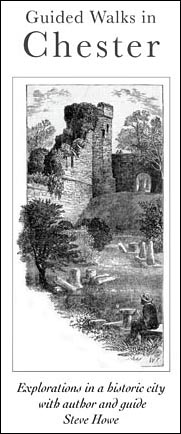 Around
the
time
of
the
18th
century
alterations
to
the
gates,
the
walls,
crumbling
and
full
of
breaches
after
their
long
battering
in
the
Siege
of Chester
during
the
Civil
War
a
century
earlier,
were
extensively
repaired
and
converted
to
provide
a
promenade
along
their
entire
length,
a
remarkable
undertaking
at
a
time
when
the
majority
of
other
British
towns
were
busily
doing
away
with
their
ancient
defences. Around
the
time
of
the
18th
century
alterations
to
the
gates,
the
walls,
crumbling
and
full
of
breaches
after
their
long
battering
in
the
Siege
of Chester
during
the
Civil
War
a
century
earlier,
were
extensively
repaired
and
converted
to
provide
a
promenade
along
their
entire
length,
a
remarkable
undertaking
at
a
time
when
the
majority
of
other
British
towns
were
busily
doing
away
with
their
ancient
defences.
Since
that
time,
many
thousands
of
visitors
have
enjoyed
the
two-mile
walk
around
Chester's
ancient
circuit
of
city
walls.
It
remains
a
fascinating
experience
and
should
be
considered
an
essential
part
of
your
visit
to
the
UK.
So
read
the
accounts
of
generations
of past
visitors
to
Chester- and
see
below
for
details
of
our
informative
and
entertaining
guided
walks
around
the
sights
of
this
most
unique and memorable
of
English
cities.
Chester
Today
Modern
Chester
is
by
no
means
'set
in
amber'
but
is
a
living,
growing
place
facing
the
same
problems
and
pressures
as
most
of
Britain's
other
historic
cities. Many
visitors,
having
admired
the
popular,
nostalgic
paintings
of Louise
Rayner and
read
old traveller's
tales of "Quaint,
sleepy,
crumbling
Chester",
are
surprised
to
encounter
the
rapidly-expanding
industrial,
commercial
and
residential
areas
surrounding
the
town
and
the
too-often
mediocre
and
inappropriate
modern
developments
within
the
city
itself.
Many
are
also
surprised
to
discover
that,
in
a
place
fond
of
referring
to
itself
as
'Roman
City', actual Roman
antiquities
are
somewhat
thin
on
the
ground,
having
been
largely
bulldozed
or
buried
to
make
way
for
shopping
precincts,
council
offices,
courthouses and hotels...
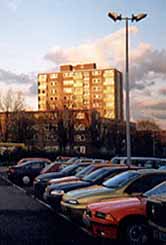 As
a
caring
resident,
this
writer
is
inclined
to
agree
with
them
and
will
be
discussing
some
of
these
blots
as
we
encounter
them
during
the
course
of
our
wanderings. As
a
caring
resident,
this
writer
is
inclined
to
agree
with
them
and
will
be
discussing
some
of
these
blots
as
we
encounter
them
during
the
course
of
our
wanderings.
In
contrast
to
British
cities
such
as
Liverpool
and
Coventry,
Chester
largely
escaped
major
damage
during
the
Second
World
War,
but
the
straightened
economic
conditions
that
followed
nevertheless
produced
years
of
neglect
and
under-maintainance
to
the
historic
core
of
the
city
centre,
resulting
in
levels
of
dereliction
today's
visitors
would
find
difficult
to
believe.
Alongside
the
rise
of
ring
roads,
car
parks
and
precincts,
it
should
be
remembered
that,
during
the
1970s
and
80s,
there
also
took
place
a
programme
of
rescue
and
restoration
on
a
heroic
scale
of
literally
hundreds
of
the
buildings
we
prize
today
and
some
of
these
stories
will
also
be
told.
Transport,
too,
has
long
been
the
subject
of
heated
local
debate.
Some
say
that,
in
the
face
of
competition
from
nearby
out-of-town
'shopping
cities',
business
in
Chester
can
only
prosper
by
welcoming
the
car
driver
into
the
city
centre
(despite
the
resulting
congestion
and
pollution
that
plagued
it
in
the
past),
increasing
the
number
of
parking
places
and
reducing
their
charges-
while
others
say
that
visitors
and
shoppers
respond
far
more
positively
to
the
relaxed
and
unhurried
atmosphere
experienced
when
they
are
no
longer
forced
to
share
the
streets
with
motor
vehicles.
Most
welcome
to
many
citizens
has
been
the
slow-but-steady
increase
in
the
numbers
of
cycleways/footpaths
in
and
around
Chester,
allowing
them
safe,
easy,
car-free
access
to
both
the
city
centre
and
its
wonderful
surrounding
countryside.
Among
these
are
the
recently-completed Riverside Path, the restored
towpath
of
the Shropshire
Union
Canal and
the
magnificent
route
along
the
former Mickle
Trafford-Deeside
Railway-
sadly
currently
threatened
by
a controversial
council
plan
to
construct
a
bus
route
along
it.
Many
mourn
the
dramatic
decline
in
traditional
businesses
in
Chester
city
centre
of
recent
years.
As
a
child,
this
writer
vividly
remembers
the
enthusiasm
of
female
members
of
his
family
at
the
prospect
of
a
shopping
trip
to
Chester,
where
he
would
be
forced
to
endure
a
seemingly-endless
round
of
exotic
shops
from
where
could
be
obtained
all
manner
of
delights
unknown
in
battered,
post-war
Liverpool.
Studying
photographs
of
the
main
shopping
areas
dating
from
even
just
a
few
decades
ago
reveals
grocers,
confectioners,
butchers,
ironmongers,
tailors,
photographers
and
the
like
(and
a
lot
more pubs than
now)
occupy
the
majority
of
the
shops
along
the
ancient Rows.
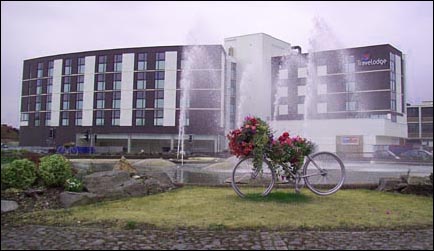 Today,
the
tables
seem
to
have
been
been
somewhat
turned,
as Liverpool city
centre
seems
to
be
thriving
while
ludicrously-high
levels
of
rent
and
rates
in
Chester
have
ensured
that
virtually
all
of
the
old
family-run
businesses
have
now
gone,
replaced
by
estate
agents,
mobile
phone
shops,
national
chain
stores-
and
especially
by
a
plague
of
coffee
shops,
of
which
an
excessive
number
seem
to
have
opened
of
recent
times. Today,
the
tables
seem
to
have
been
been
somewhat
turned,
as Liverpool city
centre
seems
to
be
thriving
while
ludicrously-high
levels
of
rent
and
rates
in
Chester
have
ensured
that
virtually
all
of
the
old
family-run
businesses
have
now
gone,
replaced
by
estate
agents,
mobile
phone
shops,
national
chain
stores-
and
especially
by
a
plague
of
coffee
shops,
of
which
an
excessive
number
seem
to
have
opened
of
recent
times.
At
the
time
of
writing
for
example-
Summer
2001-
a
smallish
vacant
shop
near
The
Cross
was
available
at
a
rent
of seventy
thousand
pounds per
year
(no
wonder
you
can't
buy
a
bag
of
nails
or
a
packet
of
tea
in
Chester
city
centre!)
while,
at
the
same
time,
two
long-established
art
businesses
and
a
wonderful
toy
museum
were
being
forced
to
close
down.
Similarly,
there
was
a
time
when
most
people
lived
within
and
close
to
the
City
Walls
while
the
more
affluent
removed
themselves
to
the
leafy
suburbs.
Today,
most
of
those
local
folk
who
reside
on
the
large
post-war
estates,
well
out
of
sight
on
the
edge
of
the
city,
would
find
it
impossible
to
be
able
to
afford
the
so-called
'luxury'
apartments
and
town
houses
currently
springing
up
in
numerous
locations
in
the
centre.
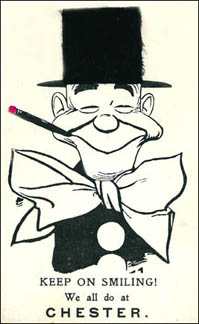 Valued facilities continue to disappear from the city centre- hardly a week goes by without news of another traditional pub closing. The vast, and apparently inevitable, Northgate Redevelopment, recent announcements concerning the planned replacement of the award-winning Northgate Arena leisure centre with yet another hotel and the acquisition of our last city centre cinema- the Odeon- by a nightclub company are current sources of great local concern, and the continuing imposition within our historic city of ghastly 1960s-style structures such as the Travelodge illustrated on the right beggars belief... Valued facilities continue to disappear from the city centre- hardly a week goes by without news of another traditional pub closing. The vast, and apparently inevitable, Northgate Redevelopment, recent announcements concerning the planned replacement of the award-winning Northgate Arena leisure centre with yet another hotel and the acquisition of our last city centre cinema- the Odeon- by a nightclub company are current sources of great local concern, and the continuing imposition within our historic city of ghastly 1960s-style structures such as the Travelodge illustrated on the right beggars belief...
Some
may
call
it
'commercial
reality',
others
philistinism and naked
greed-
the
results
are, sadly,
the
much
the
same.
The city is awash with well-funded organisations purporting to represent, speak for, and publicise Chester to the world but precious few of them would appear even remotely competent to do so.
This
ancient
city
of
Chester is changing
rapidly-
many
say
too
rapidly.
What
sort
of
a
place
it
will
become,
and
whether,
having
done
so,
it
will
have
managed
to
retain
some
portion
of
its
uniqueness,
its
attraction
for
residents
and
fascination
for
visitors
from
all
over
the
globe-
or become just another Anytown UK- are
questions
only
time
can
answer. Chester Renaissance, the council sponsored- but nontheless unelected- body charged with dragging the old place kicking and screaming into the 21st century, declares its aim is to "make Chester a must-see city by the year 2015" and The One City Plan- the latest in a long line of such plans- has just (June 2102) been published as its blueprint. That it has been a 'must see city' to millions of visitors for many centuries is something seemingly lost upon these imported 'experts'. What sort of city they manage to turn it into we must wait and see; will the world continue to flock to admire their handiwork- a place of bright new hotels, apartments, 'business quarters' and shopping precincts? We wonder.
So we invite you to enjoy Old Chester while you can!
Check
out
the route
map, search our site in detail with Google or go
straight
to
the start of our walk at the Northgate... |